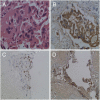Caesarean scar choriocarcinoma: a case report and review of the literature
- PMID: 24887563
- PMCID: PMC4026121
- DOI: 10.1186/2047-783X-19-25
Caesarean scar choriocarcinoma: a case report and review of the literature
Abstract
Objective: To report the clinical characteristics, pathologic findings and treatments of a patient with a Caesarean scar choriocarcinoma.
Patient history: A 22-year-old woman had a diagnosis of primary gestational choriocarcinoma in a uterine Caesarean scar misdiagnosed as a normal Caesarean scar pregnancy. The patient underwent selective uterine artery embolization coupled with methotrexate arterial injection, along with dilatation and curettage of the uterine Caesarean scar. Finally, she received eight courses of multiagent chemotherapy. The reproductive function of the patient was preserved.
Conclusions: Primary gestational choriocarcinoma out of the uterine corpus is a rare disease. A Caesarean scar choriocarcinoma is an extremely unusual example of this entity because of its unique position. To the best of our knowledge, this is the first report of this phenomenon. Our experience and a literature review suggest that a clinical diagnosis of a primary gestational choriocarcinoma of the uterine Caesarean scar is difficult to make, and uterine artery embolization is beneficial to prevent massive bleeding before curettage.
Figures


Similar articles
-
[Cesarean scar ectopic pregnancies: combined modality therapies with uterine artery embolization before surgical procedure].Gynecol Obstet Fertil. 2015 Mar;43(3):191-9. doi: 10.1016/j.gyobfe.2015.01.015. Epub 2015 Feb 25. Gynecol Obstet Fertil. 2015. PMID: 25724449 French.
-
Combination of medical and surgical management in successful treatment of caesarean scar pregnancy: a case report series.BMC Pregnancy Childbirth. 2020 Oct 13;20(1):617. doi: 10.1186/s12884-020-03237-8. BMC Pregnancy Childbirth. 2020. PMID: 33050911 Free PMC article.
-
Effectiveness, complications and reproductive outcome of selective chemoembolization with methotrexate followed by suction curettage for caesarean scar pregnancy - A prospective observational study.Eur J Obstet Gynecol Reprod Biol. 2019 Oct;241:56-59. doi: 10.1016/j.ejogrb.2019.08.004. Epub 2019 Aug 13. Eur J Obstet Gynecol Reprod Biol. 2019. PMID: 31437622
-
Uterine artery embolization combined with methotrexate in the treatment of cesarean scar pregnancy: results of a case series and review of the literature.J Vasc Interv Radiol. 2012 Dec;23(12):1582-8. doi: 10.1016/j.jvir.2012.08.013. J Vasc Interv Radiol. 2012. PMID: 23177105 Review.
-
Primary cesarean scar choriocarcinoma: A case series and literature review.Int J Gynaecol Obstet. 2023 Aug;162(2):433-439. doi: 10.1002/ijgo.14702. Epub 2023 Feb 21. Int J Gynaecol Obstet. 2023. PMID: 36710632 Review.
Cited by
-
Uterine mass after caesarean section: a report of two cases.BMC Pregnancy Childbirth. 2020 Sep 3;20(1):508. doi: 10.1186/s12884-020-03213-2. BMC Pregnancy Childbirth. 2020. PMID: 32883223 Free PMC article.
-
Placenta Site Trophoblastic Tumor and Choriocarcinoma from Previous Cesarean Section Scar: Case Reports.Iran J Med Sci. 2018 Jul;43(4):426-431. Iran J Med Sci. 2018. PMID: 30046213 Free PMC article.
-
Hydatidiform mole in a scar on the uterus: A case report.World J Clin Cases. 2020 Apr 26;8(8):1547-1553. doi: 10.12998/wjcc.v8.i8.1547. World J Clin Cases. 2020. PMID: 32368549 Free PMC article.
-
[Gestational trophoblastic diseases in cesarean scar: an analysis of 20 cases].Zhejiang Da Xue Xue Bao Yi Xue Ban. 2017 May 25;46(5):529-536. doi: 10.3785/j.issn.1008-9292.2017.10.13. Zhejiang Da Xue Xue Bao Yi Xue Ban. 2017. PMID: 29488721 Free PMC article. Review. Chinese.
-
Long-term outcome of ultrasound-guided focused ultrasound ablation for gestational trophoblastic neoplasia in the cesarean scar: a case report.BMC Womens Health. 2022 Dec 15;22(1):522. doi: 10.1186/s12905-022-02114-0. BMC Womens Health. 2022. PMID: 36522625 Free PMC article.
References
-
- Yahata T, Kodama S, Kase H, Sekizuka N, Kurabayashi T, Aoki Y, Tanaka K. Primary choriocarcinoma of the uterine cervix: clinical, MRI, and color Doppler ultrasonographic study. GynecolOncol. 1997;64:274–278. - PubMed
-
- Baykal C, Tulunay G, Bülbül D, Boran N, Köse MF. Primary choriocarcinoma of the uterine cervix in a postmenopausal patient: a case report. GynecolOncol. 2003;90:667–669. - PubMed
-
- Lee JD, Chang TC, Lai YM, Hsueh S, Soong YK. Choriocarcinoma of the cervix. Acta ObstetGynecolScand. 1992;71:479–481. - PubMed
-
- Veridiano NP, Gal D, Delke I, Rosen Y, Tancer ML. Gestational choriocarcinoma of the ovary. GynecolOncol. 1980;10:235–240. - PubMed
Publication types
MeSH terms
Substances
LinkOut - more resources
Full Text Sources
Other Literature Sources
Medical

